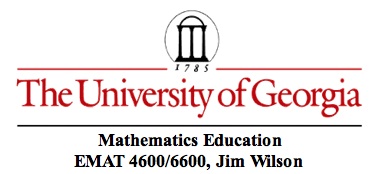

Introduction.
The task is to divide a given triangle into three regions of equal area, using line segments and points. There are several different problems that can be posed.
Here are four:
Problem 1. If a triangle ABC is given and a random point P on the triangle is selected, construct two lines through P to divide the triangle into three regions with equal area. At the right is ONE example but because P can be anywhere on the perimeter of the triangle there are several cases to consider. We will enumerate 7 of them below.
Problem 2. Given a triangle ABC, find a point D such that line segments AD, BD, and CD trisect the area of the triangle into three regions with equal areas. Define D and prove that the triangle is divided into three regions of equal area. Show a construction for finding D.
Problem 3. Given a triangle ABC, and given a point E. such that line segments AE, BE, and CE trisect the area of the triangle into three regions with equal areas. Show a construction and prove that it divides the triangle into three regions of equal area.
Problem 4. Given a triangle ABC. Construct two line segments parallel to the base BC to divide the triangle into three regions with equal areas. Prove that the construction divides the triangle into three regions of equal area.
If there is given a point P on the side of the triangle, then there are seven ways to construct three equal areas with lines drawn from P. The sequence below shows the seven patterns with P moving from right to left.

Click here to see a GSP animation of this problem.
In the first case, P is the base vertex on the right hand side of the triangle, and in the seventh case, P is the base vertex on the left hand side of the triangle. The construction in each case involves trisecting the segment on the opposite side of the triangle and connecting the vertex by segments to the two trisection points. Since we know at least five ways to construct the trisection of a line, the construction task for these two cases can be assumed.
Much needs to be discovered in the other cases.
For the third and the fifth cases, P is located such that a segment drawn to the opposite vertex determines a triangle that is one-third the area of the original triangle. This means P is located at a trisection point on the base of the triangle. But then the remaining two-thirds of the original triangle must be divided into two equal areas by a line from P through the opposite side, making two triangles. These triangles have the same height, so the point must be the midpoint of that side. That is, if P is a trisection point of the base, then the original triangle is divided into three equal areas by lines from P to the vertex and from P to the midpoint of the side along the two-thirds section.This leaves three constructions to be determined, the second, fourth, and sixth in the sequence above. These correspond to the cases where P is neither a vertex nor a trisection point on the base. In the second case, P is in the right third of the base; in the fourth case, P is in the center third of the base; and in the sixth case, P is in the left third of the base. Clearly, the constructions for the second and sixth cases will be virtually the same.
Construction Outline
Each case could be constructed by using the result of a slightly different construction. That is,Given a triangle ABC with a given point on the base that is neither a vertex nor a trisection point, construct a line through P that cuts off a triangle one third the area of ABC.
Note that if we know this construction, we could use it to construct the shaded triangles in cases two, four, and six. Case four would be finished. Cases two and six could be completed by deteriming another triangle with the same length base opposite of P.Construction of a Triangle with one-third of the area and base AP
For triangle ABC, construct the altitude and find its trisection points. Again we know at least five different constructions for trisecting a line segment. The point P is given on base AC and is neither a vertex nor a trisection point of AC.
Determine which end of the base if nearest to point P. Construct a perpendiclar to AC at that end. Construct a parallel line to AC through the nearest trisection point on the altitude and construct a perpendicular segment from P to this line at Q.
The areas of triangle AQC is one third the area of triangle ABC.
Extend line AQ to intersect with the perpendicular to C at point D.
Triangle APD has the same area as triangle AQC because AP/AC = PQ/ CD and therefore (AP)(CD) = (PQ)(AC). Each side of this latter equation is twice the area of the respective triangles.
Now any point on a line parallel to AC through D could be the vertex of a triangle with base AP that has area one-third the area triangle ABC. The intersection point with side AB will determine a vertex E of the desired triangle. Draw line PE.